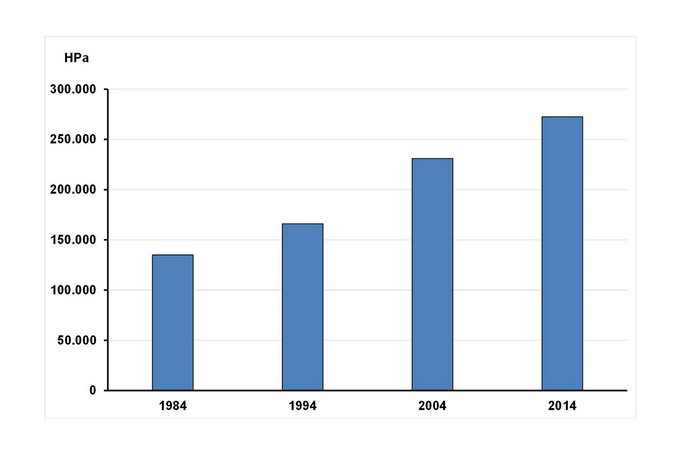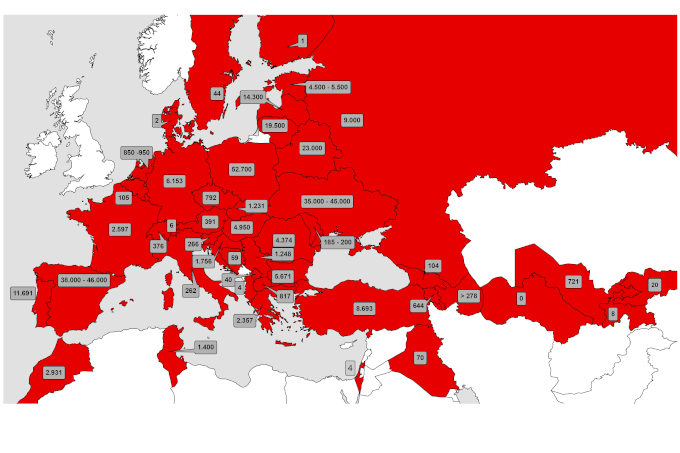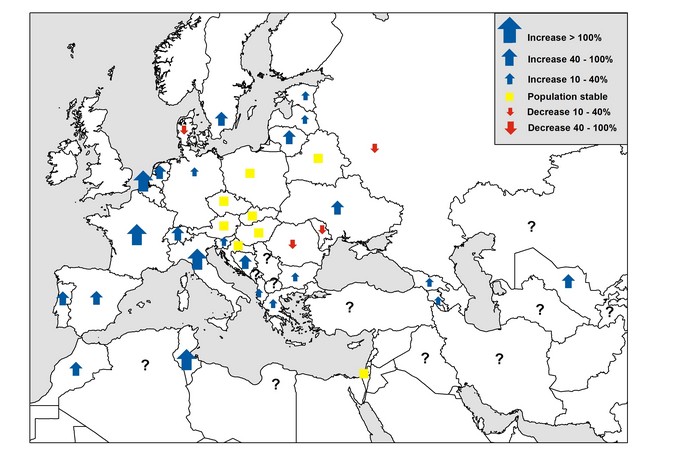Ergebnisse des 7. Internationalen Weißstorchzensus 2014/15
Internationale Bestandserfassung
Mit Hilfe des Zensus werden grundlegende Daten über die globale Populationsdynamik des Weißstorchs geschaffen und eine Schätzung des Weltbestandes der Art möglich. Die Ergebnisse erlauben langfristige Populationsschwankungen und deren Ursachen zu interpretieren und regionale Entwicklungen zu erkennen, die Rückschlüsse für den zukünftigen Schutz der Art zulassen.

Abb. 1. Entwicklung der Weltpopulation des Weißstorchs nach den Bestandsschätzungen der internationalen Erfassungen seit 1984.
Der Weißstorch brütete 2014 in 54 Ländern Europas, Nordafrikas und Asiens. Die nationalen Erfassungen wurden von BirdLife Partnern, NGOs, wissenschaftlichen Instituten oder einzelnen engagierten Personen organisiert und in 48 Ländern durchgeführt. Darüber hinaus flossen Daten aus Veröffentlichungen oder früheren Erfassungen in die Ergebnisse des 7. Internationalen Weißstorchzensus ein. Auf dieser Datengrundlage konnte der Weltbestand des Weißstorchs 2014/15 auf 265.000 - 280.000 Paare (HPa) geschätzt werden.

Abb. 2: Ergebnisse des 7. Internationalen Weißstorchzensus. Anzahl der Brutpaare (HPa) pro Land für die Jahre 2014/15.
Seit 2004 ein Bestandsanstieg um 18 Prozent. Weltweit hat sich der Brutbestand seit 1984 verdoppelt (Abb. 1). Die Ergebnisse der einzelnen Länder sind Tab. 1 und Abb. 2 zu entnehmen. Vollständige Erfassungen erfolgten 2014 erstmals auch im Westbalkan und in Zentralasien, wo die Unterart Ciconia c. asiatica brütet. In der Türkei fand von 2011 bis 2013 eine erste vollständige Erfassung des Weißstorchbestandes statt. Neuansiedlungen wurden in Finnland, Liechtenstein und Luxemburg gemeldet.
Die Ostpopulation des Weißstorchs, die östlich des Mittelmeers ins Winterquartier in Ost- und Südafrika zieht, beträgt etwa 201.500 Paare und hat seit 2004 um 14% zugenommen. Dabei haben sich die Bestände regional unterschiedlich entwickelt (Abb. 3). Während im westlichen Teil in den Ländern Mitteleuropas (Polen, Tschechien etc.) die Bestände weitgehend stabil geblieben sind, sind in Osteuropa (Ukraine, Baltische Länder) Zunahmen zu verzeichnen. Die Situation des Weißstorchs in Russland ist unklar. In der südöstlichen Population kommen sowohl Bestandszunahmen (Westbalkan, Griechenland und Bulgarien) als auch Rückgänge (Rumänien, Moldau) vor. Die Westpopulation, die die Bestände umfasst, die im westlichen Mittelmeerraum oder in Westafrika überwintern, beträgt etwa 68.500 Paare und weist seit 2004 eine starke Zunahme um 34% auf.
English: Results of the 7th International White Stork Census 2014/15
English: Results of the 6th International White Stork Census

Fig. 1. Development of the world population of the White Stork according to the population estimates of the international surveys since 1984.
The 7th International White Stork Census took place in 2014 and 2015 as a joint project of NABU and BirdLife International. NABU was responsible for the international coordination of the census and collection of the results.
The census provides basic data on the global population dynamics of the species and enables estimating the overall population size. The long-term dataset allows the detection of regional population fluctuations and their causes. These can be used to identify necessary conservation actions to better protect the species.

Fig. 2. Results of the 7th International White Stork Census. Number of breeding pairs (HPa) per country for the years 2014/15.
White storks bred in 54 European, North-African and Asian countries in 2014. National census data were gathered by BirdLife partners, NGO’s, scientific institutes, and highly engaged Individuals in 48 countries. Furthermore, published data or data from earlier counts were used to complete the picture. Based on these datasets the worldwide number of White Stork breeding pairs in 2014/15 was estimated to 265,00 – 280,000 pairs (HPa). Since 2004 the world population accordingly increased by 18 % and doubled since 1984. Results from single countries are shown in Tab. 1 and Fig. 1. Nationwide counts for the subspecies Ciconia c. asiatica were conducted for the first time for the Western Balkans and Central Asia in 2014. In Turkey, a first countrywide census was conducted from 2011 to 2013. Resettlements were recorded in Finland, Liechtenstein, and Luxembourg.
The eastern population of the White Stork, breeding east of the Mediterranean Sea and wintering in East- and South Africa estimates about 201,500 pairs and increased by 14 % since 2004. Regional population sizes however developed differently (Fig. 3). While countries in the western part of Central Europe (Poland, Czech Republic, etc.) remained stable, Eastern European populations increased (Ukraine and Baltic countries). Population size of the White Stork in Russia remains unclear. The South-eastern population shows increasing (Western Balkans, Greece and Bulgria) as well as decreasing local populations (Romania, Moldavia). The Western populations including birds wintering in the western part of the Mediterranean Sea or West Africa estimates 68.500 pairs and strongly increased by 34 % since 2004.


